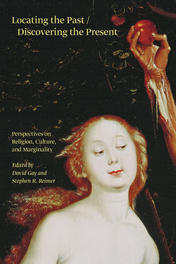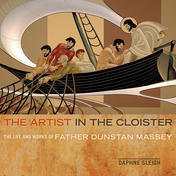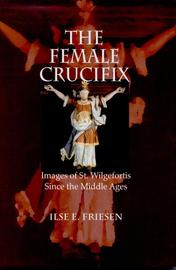Subjects & Themes


Locating the Past / Discovering the Present


This book is about a legendary and largely forgotten female saint whose images have recently been rediscovered and whose significance can now be interpreted in a new light. Since the Middle Ages, this crucified saint has been known by various names, including Wilgefortis (possibly derived from virgo fortis, or alternatively hilge vratz, or holy face), as well as Uncumber, Ontcommer, Kummernis and Liberata. All of these names suggest the ability of this “strong virgin” to liberate those in bondage and grief (“Kummer”). The popular cult of this mysterious saint at one point nearly rivalled that of the Virgin Mary, but ever since the Reformation, and particularly since the Enlightenment, her veneration has been criticized and discouraged by the Catholic Church. In parts of Central Europe, her votive paintings were deliberately destroyed, wall paintings which portrayed her were whitewashed and statues and oil paintings came to be confined to church attics or storage rooms, or were simply left to deteriorate in monastery vaults.
Images of this bearded female saint, who was typically depicted being crucified upon a cross, were frequently dismissed by the official Church as a grotesque and bizarre aberration of the veneration of the crucified Christ. Scholars in various fields have historically assumed that these strange images originated from a misinterpretation of portrayals of the robed Christ on the cross, especially in connection with a sculpture called the Volto Santo in Lucca, Italy, which is perhaps the most famous example of the Byzantine or Eastern type of the robed crucifix. This early medieval statue of the “holy face” was once the focus of mass pilgrimages along roads leading from Central and Northern Europe to Italy. Copies of this miracle-working robed crucifix were also produced in order to provide a substitute for pilgrimages to Lucca; consequently, various communities also had their own cult sites dedicated to the “holy face. “
These local images were typically executed in the form of wall paintings, sculptures, stained glass windows, oil paintings, prints or book illuminations. Portrayals of this miracle-working robed crucifix were eventually to be found across most of Europe, ranging from Spain in the west to Slovenia in the east. Some of these images were closely modelled on the Lucca statue, and consequently portrayed an unmistakeably male figure. Others, however, combined the traditional bearded face with a female body that featured well-rounded breasts, a delicate waistline and female clothing adorned with precious jewellery.
In this study, it will be argued that the representations and stories which were connected with these sometimes disturbingly androgynous crucifixes resulted from a much more complex and diverse set of reasons than a mere misunderstanding of a particular image of the crucified Christ. It will be shown that many of these later images were deliberately created in order to portray a female saint, with or without the intention of maintaining any visual connection with the Volto Santo. Additionally, a number of male crucifixes were robed in unmistakeably female clothing and jewellery in order to transcend strict gender boundaries. Over the course of several centuries, additional images, names and legends became prevalent, all of them centring on a crucified female saint who was held to have become Christlike, both in terms of her physical appearance and with regard to her martyrdom on the cross.
An examination of a variety of historical images of St. Wilgefortis, which were created over the course of eight centuries, will also demonstrate that some of these works of art were deliberately intended to be ambiguous; whether one is inclined to interpret them as representing Christ or the female martyr is something for the individual viewer to decide. This, in turn, raises questions which relate to some of the most contentious and controversial gender issues of the late twentieth century. The history of this saint has triggered debates over contemporary gender roles and sexual identity, including, for example, the question of whether female hirsutism is in fact a purely medical condition or whether it can be brought about intentionally, as has been claimed in the case of the female saint who is the focus of this book. Thus, for instance, St. Uncumber — one of the many names by which the saint has been known over the centuries — is included in a list of specifically “transvestite saints” as part of an internet-based Calendar of Lesbian, Gay, Bisexual, and Transgender Saints which is discussed at greater length elsewhere in this book.
From a feminist perspective, it is interesting to note that over the course of previous centuries, this bearded and crucified female saint has been called upon particularly by victims of enforced marriages and various forms of sexual abuse, including rape and incest. In this primary role, St. Wilgefortis has historically served as a cultural reference for personal accounts of physical and emotional abuse which would otherwise have been glossed over, or indeed, suppressed entirely. Thus, these images relate to an unwritten history of violence, especially against women. Insofar as women invoked the bearded saint with regard to various female health concerns, including cancer of the uterus, anxieties about infertility and complications of pregnancy and delivery, portrayals of the saint were also the focus of medical and emotional concerns, as well as prayers. Portrayed with torn ropes, she was also a comforter and intercessor for people in bondage, especially those in prison, as well as for conscripted soldiers. Finally, her presence was invoked by people who were dying, insofar as she was believed to have wrested life out of death through her own Christlike agony. In this connection, it was believed that she personified the promise of eventual resurrection for the faithful. Some of her portrayals, in fact, were originally created for charnel houses and burial chapels that were situated next to graveyards; some of these locations are still preserved today.




